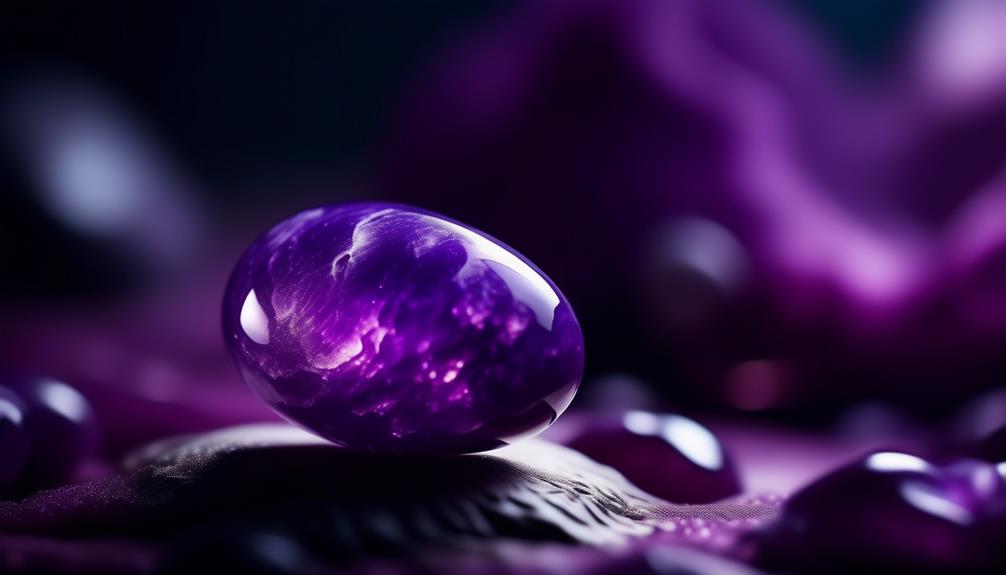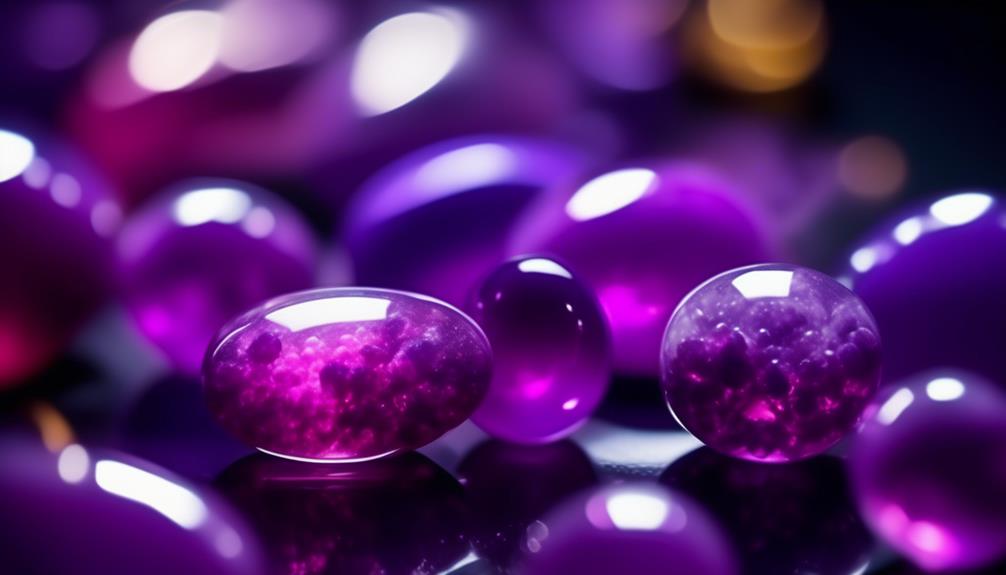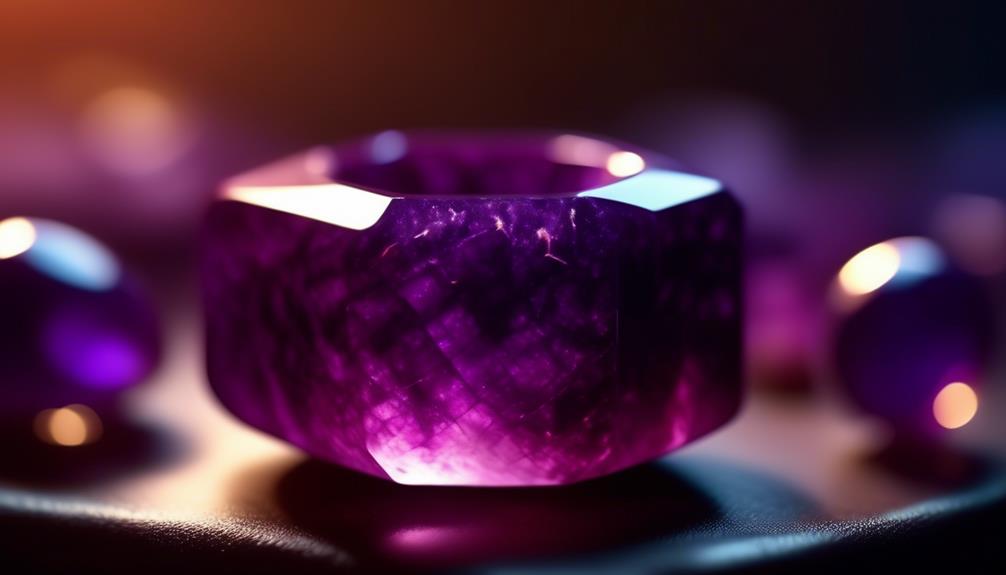Purple jade, with its captivating hue and mystical allure, has long been revered for its beauty and significance. As a writer exploring the worth of this precious gemstone, it is essential to approach the topic with a professional demeanor, devoid of excessive enthusiasm. With its enigmatic nature and limited availability, the value of purple jade has been a subject of intrigue and curiosity. However, understanding the factors that contribute to its worth requires a comprehensive analysis of its rarity, quality, demand, historical significance, and market trends. By delving into these aspects, we can begin to unravel the enigma surrounding the value of purple jade and determine whether it truly lives up to its captivating allure.
Key Takeaways
- Purple jade is a rare and valuable gemstone sought after by collectors and enthusiasts worldwide.
- The color grade, clarity, and transparency of purple jade significantly impact its value.
- Deeper and more vibrant purples are considered more desirable and command higher prices.
- Size and carat weight also play a crucial role in determining the value of purple jade.
Rarity of Purple Jade

Purple jade is a rare and valuable gemstone sought after by collectors and enthusiasts worldwide. Its rarity is a significant factor in its high value and desirability. The scarcity of purple jade in nature contributes to its exclusivity and makes it a prized possession among gemstone connoisseurs.
Purple jade's rarity is a result of various factors. Firstly, the geological conditions necessary for the formation of purple jade are limited. It requires specific mineral compositions and a unique combination of temperature and pressure to create the distinct purple hues. These conditions are rarely found, making the occurrence of purple jade in nature quite rare.
Furthermore, the limited availability of purple jade is also due to the challenges involved in its extraction and processing. The extraction process requires specialized knowledge and expertise to ensure the preservation of its color and quality. Moreover, the intricate cutting and polishing techniques required for purple jade demand skilled craftsmanship, further limiting its availability in the market.
Beyond its rarity, purple jade holds significant cultural symbolism, adding to its appeal. In many cultures, purple is associated with royalty, spirituality, and wisdom. The color purple is often associated with power, luxury, and prestige, making purple jade a symbol of status and wealth.
Quality Factors Affecting Value
When determining the value of purple jade, several quality factors come into play. One important factor is the color grade, as a vibrant and even purple hue is highly sought after. Additionally, the clarity and transparency of the stone play a significant role, with fewer inclusions and greater transparency indicating a higher quality specimen. Lastly, the size and carat weight of the purple jade can also impact its value, as larger and heavier stones are generally considered more valuable.
Color Grade Importance
The importance of color grade in determining the value of purple jade cannot be overstated. The color of purple jade can vary greatly, and its color intensity and hue play a significant role in its market value analysis. Here are four key factors that contribute to the color grade importance of purple jade:
- Color Intensity: The strength and richness of the purple hue greatly impact the value of purple jade. Deeper, more vibrant purples are considered more desirable and command higher prices.
- Hue: The specific shade of purple also affects the value of purple jade. Some hues, such as violet or lavender, may be more sought after than others.
- Evenness: An even distribution of color throughout the jade is preferred. Areas with inconsistent color saturation or patches of different hues can lower the value.
- Clarity: The transparency and lack of impurities in purple jade can enhance its color grade and subsequently its value.
Clarity and Transparency
The quality factors influencing the value of purple jade extend beyond its color grade, with clarity and transparency playing a crucial role in determining its market worth. Clarity refers to the presence of any visible internal flaws or external blemishes in the gemstone. A higher level of clarity indicates a purer and more valuable purple jade. Transparency, on the other hand, refers to the ability of light to pass through the gemstone. Purple jade with excellent transparency allows light to pass through without obstruction, enhancing its brilliance and value. To provide a clearer picture, the table below summarizes the clarity assessment and pricing transparency of purple jade:
| Clarity Assessment | Pricing Transparency |
|---|---|
| Flawless | High |
| Slightly Inclusive | Medium |
| Inclusive | Low |
Size and Carat Weight
Size and carat weight are significant quality factors that have a direct impact on the value of purple jade. When determining the worth of purple jade, it is crucial to consider the following:
- Carat Weight Importance: Carat weight refers to the weight of the gemstone, and it plays a crucial role in determining its value. Generally, the higher the carat weight, the more valuable the purple jade. However, it is important to note that carat weight alone is not the sole determinant of value.
- Size Considerations: The size of the purple jade also affects its value. Larger pieces are often more sought after and command higher prices. However, size should be considered in conjunction with other quality factors to accurately assess the value.
- Rarity: Rare sizes and carat weights can greatly increase the value of purple jade. Unusual or unique sizes are highly prized by collectors and enthusiasts.
- Proportions and Cut: The way the purple jade is cut and its proportions can affect its perceived size and visual appeal. Well-cut stones with proper proportions can enhance the overall beauty and value of the gem.
Considering the carat weight importance and size considerations, along with rarity and the quality of the cut, is essential in determining the value of purple jade.
Determining Market Demand
Determining market demand for purple jade involves considering various factors. These factors include the rarity of purple jade, consumer preferences, and the overall economic conditions. Pricing considerations are also important, as the demand for purple jade can be influenced by its price relative to other gemstones. Understanding the supply and demand dynamics in the market is crucial for accurately determining market demand for purple jade.
Market Demand Factors
Market demand factors play a crucial role in assessing the level of consumer interest and purchasing behavior for a particular product or service. When it comes to purple jade, several factors affect market demand and determine its investment potential. Here are four key factors to consider:
- Rarity: The scarcity of purple jade in the market can significantly impact its demand and value. The rarer the gemstone, the higher the demand and potential for investment.
- Color and Quality: The color and quality of purple jade greatly influence its desirability. Vibrant and intense shades of purple, along with high clarity and translucency, command a higher market demand.
- Cultural Significance: Purple jade holds cultural significance in certain communities, especially in Chinese culture. This cultural association can drive demand among collectors and enthusiasts.
- Market Trends: The overall market trends and consumer preferences also play a significant role in determining the demand for purple jade. Factors like fashion trends, celebrity endorsements, and global economic conditions can impact the market demand for this gemstone.
Considering these market demand factors can help investors and collectors assess the investment potential of purple jade.
Pricing Considerations
Pricing considerations are a critical aspect when determining the market demand for purple jade, as it directly impacts the perceived value and affordability of this gemstone. Market value fluctuations and international market demand play a significant role in setting the price of purple jade. Understanding these factors helps gemstone dealers and buyers make informed decisions.
To illustrate the importance of pricing considerations, let's consider the following table:
| Pricing Considerations | Impact |
|---|---|
| Market Value Fluctuations | Market value fluctuations can significantly influence the price of purple jade. Changes in supply and demand, as well as economic conditions, can lead to price volatility. |
| International Market Demand | The international market demand for purple jade can drive up its price. If there is high demand from countries with a strong affinity for this gemstone, prices may increase. On the other hand, low demand may lead to lower prices. |
Supply and Demand Dynamics
An essential factor in understanding the market demand for purple jade is the dynamics of supply and demand. To determine the market demand for purple jade, one must consider the following:
- Rarity: Purple jade is a rare gemstone, which increases its desirability among collectors and investors. The limited supply contributes to its high market value.
- Aesthetics: Purple jade is prized for its vibrant purple color, which is unique and visually appealing. Its beauty attracts buyers who value its aesthetic qualities.
- Cultural Significance: Purple jade holds cultural significance in certain regions, such as China, where it is associated with wealth, prosperity, and spiritual healing. This cultural connection drives the demand for purple jade in these markets.
- Market Trends: The demand for purple jade is influenced by market trends, such as growing interest in gemstone investments and increasing demand for unique and rare gemstones. Investors looking for alternative investment opportunities may see purple jade as a valuable addition to their portfolios.
Understanding these supply and demand dynamics can help investors identify potential investing opportunities in the purple jade market.
Historical Significance and Cultural Value
Throughout history, purple jade has played a significant role in various cultural traditions and has been revered for its deep symbolism and esteemed value. The cultural symbolism associated with purple jade is rooted in its vibrant color and unique properties. In ancient Chinese culture, purple was considered the color of royalty and power, and purple jade was highly prized for its association with these qualities. It was believed to bring good luck, prosperity, and protection against evil spirits.
Purple jade has also been used in historical preservation efforts to showcase the rich cultural heritage of different civilizations. Its use in art and jewelry has allowed for the preservation and documentation of ancient traditions and craftsmanship. Many museums and private collectors value purple jade for its historical significance and use it to educate the public about the cultural practices of the past.
The cultural value of purple jade extends beyond its historical significance. It is often regarded as a symbol of beauty, elegance, and sophistication. Its rarity and unique color make it highly sought after by collectors and enthusiasts alike. In recent years, there has been a growing interest in purple jade as a precious gemstone, with jewelry designers incorporating it into their creations to add a touch of luxury and exclusivity.
As society continues to evolve, the cultural significance and value of purple jade may continue to change. However, its historical importance and symbolism will always be revered. Purple jade serves as a tangible link to our ancestors, reminding us of the rich cultural traditions that have shaped our world. Its existence is a testament to the enduring beauty and timeless appeal of this precious gemstone.
Pricing Factors and Market Trends

Purple jade's market value is influenced by a variety of factors, including its rarity, quality, and demand in the jewelry and gemstone industry. Understanding these pricing factors and market trends is crucial for both buyers and sellers in order to make informed decisions and ensure fair transactions. Below are four key considerations that impact the market prices and gemstone appraisals of purple jade:
- Rarity: Purple jade is relatively rare compared to other types of jade, such as green or white jade. Its scarcity contributes to its higher market value, as collectors and enthusiasts are willing to pay a premium for the unique and distinctive color.
- Quality: The quality of purple jade is determined by factors such as color intensity, translucency, and lack of impurities. Stones with deep, vibrant purple hues and good clarity are considered higher in quality and command higher prices in the market.
- Demand: The level of demand for purple jade in the jewelry and gemstone industry plays a significant role in determining its market value. If there is a high demand among consumers, prices are likely to increase. Conversely, if demand decreases, prices may drop.
- Market Trends: Market trends, influenced by factors such as fashion, cultural preferences, and economic conditions, can impact the prices of purple jade. For example, if purple becomes a popular color in fashion or there is an increase in demand from a specific market, prices may rise accordingly.
It is important to note that market prices for purple jade can fluctuate over time, so regular monitoring and gemstone appraisals are essential to stay updated with the current market value. By considering these pricing factors and market trends, both buyers and sellers can navigate the purple jade market with confidence and make informed decisions.
Investing in Purple Jade: Is It Worth It?
Investing in purple jade requires a careful assessment of its market value and potential for long-term growth. To determine whether investing in purple jade is worth it, a thorough market analysis is necessary.
Purple jade is a rare and highly sought-after gemstone, known for its vibrant purple color and unique properties. Its scarcity in the market contributes to its high value and investment potential. However, market conditions can fluctuate, and it is crucial to understand the current trends and factors affecting the purple jade market.
A comprehensive market analysis involves evaluating the supply and demand dynamics of purple jade, considering factors such as mining output, consumer preferences, and geopolitical influences. By examining historical data and trends, investors can gain insights into the potential growth and profitability of investing in purple jade.
In addition to market analysis, understanding the investment potential of purple jade is essential. Investing in gemstones, including purple jade, can offer diversification and potential high returns. As a tangible asset, purple jade provides a hedge against inflation and economic uncertainties. Its rarity and unique aesthetics make it an attractive investment option for collectors and enthusiasts.
However, it is important to note that investing in purple jade carries risks. The value of gemstones can fluctuate, and liquidity can be limited compared to other investment options. It is crucial to evaluate the credibility and reputation of sellers, as well as to seek professional guidance when entering the purple jade market.
Frequently Asked Questions
How Is Purple Jade Different From Other Types of Jade?
Purple jade is a unique variety of jade that distinguishes itself from other types of jade through its distinct coloration. Unlike traditional green jade, purple jade possesses a captivating purple hue that sets it apart. This vibrant color is due to the presence of trace amounts of minerals such as manganese and iron. The characteristics of purple jade, including its color and rarity, contribute to its allure and desirability among collectors and enthusiasts.
Are There Any Spiritual or Metaphysical Properties Associated With Purple Jade?
Purple jade is believed to possess spiritual benefits and healing properties. It is said to enhance spiritual growth and promote inner peace and tranquility. The unique purple hue of the jade is associated with the crown chakra, which is believed to connect individuals to their higher self and spiritual realms. This stone is also said to have a calming effect on the mind and body, promoting emotional balance and clarity. Its metaphysical properties make it a sought-after gem for those seeking spiritual enlightenment and holistic healing.
Can Purple Jade Be Artificially Enhanced or Treated to Improve Its Color or Quality?
Purple jade can indeed be artificially enhanced or treated to improve its color or quality. Various techniques are employed to achieve this, such as dyeing, heat treatment, and irradiation. Dyeing involves the use of colorants to enhance or change the natural color of the jade, while heat treatment can improve its transparency and color saturation. Irradiation, on the other hand, can alter the color of the jade by introducing radiation. These artificial enhancements and treatments are aimed at enhancing the overall aesthetic appeal and market value of purple jade.
What Are Some Common Imitations or Fake Purple Jade Products on the Market?
When it comes to identifying fake purple jade products, it is important to be aware of common imitations that are prevalent in the market. These imitations can range from dyed stones, glass or plastic replicas, to synthetic materials made to resemble purple jade. By understanding the characteristics and properties of authentic purple jade, such as its unique color distribution and natural variations, one can better differentiate between genuine and fake products. This knowledge is crucial in ensuring that consumers make informed decisions and acquire genuine purple jade products.
Are There Any Specific Regions or Countries Known for Producing High-Quality Purple Jade?
High-quality purple jade is known to be produced in various regions around the world. These regions have established a reputation for their expertise in purple jade production. The demand for purple jade in the market is driven by its rarity and unique color. The market recognizes the superior quality of purple jade from these specific regions, making it highly sought after by collectors and enthusiasts. This demand, combined with the limited supply, contributes to the value and worth of purple jade in the market.
Conclusion
In conclusion, the worth of purple jade is determined by various factors such as rarity, quality, market demand, historical significance, and pricing trends. Its value is not only monetary but also cultural, making it a sought-after gemstone. However, investing in purple jade should be done with careful consideration and research. As the adage goes, "A wise investor knows the worth of every stone, for it is the journey that determines its value."

